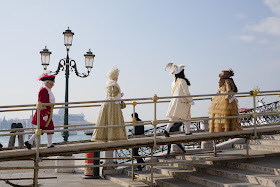People in Carnevale costumes
Rather foolishly, we have come to Venice during the second weekend of Carnevale. Everywhere there are people dressed in traditional Carnevale costumes. They seem universally patient about being photographed.
Our general idea for today's walk was to keep away from the centre and we decided to do this walk which according to our book begins at Giardini. As we headed east along the Riva della Sciavone, vast hordes were going the other way towards San Marco.
We headed inland a bit to see the Gothic church of San Giovanni in Bragora. It was beautifully plain and simple.
Inside, there were several chapels with fine artworks, but unfortunately we had no sooner got in than we had to leave as it was closing for lunch. (It would reopen 3 1/2 hours later.)
Soon we were at the canal which leads to the Arsenale, the massive former shipyard which underpinned Venice's maritime power.
Just after that we reached the start of the official walk at the Camp di San Biagio and continued along the riva which runs alongside the Canale di San Marco. The first notable sight was Via Giuseppe Garibaldi. This was built in 1808 by Napoleon, who liked large boulevards, by filling in part of the Rio di Castello. It is the widest street in Venice and quite atypical.
Further along we came to the Giardini Publici, pretty much the only green (-ish) public space in. Venice. Nearby is the site of the Venice Biennale, which I had hoped we could explore. It was unfortunately closed. On the edge of the Gardens was the Arco di San Michele, all that remains of a 16th century church demolished by Napoleon.
I rather liked this art deco memorial to an airman.
There was a great view back from the Giardini vaporetto stop with several of Venice's greatest landmarks all in view at once: from the right, the Doge's Palace and campanile of San Marco, the Dogana (Customs House), the churches of Santa Maria della Salute and San Giorgio Maggiore.
Deeper into the Giardini was the earliest building associated with the Biennale, this rather lovely greenhouse, now restored and used as a cafe.
Nearby, off the Via Guiseppe Garibaldi, was the 1885 monument to the great man.
We headed along the Via towards the island of San Pietro to find the church of San Pietro di Castelo. This was Venice's cathedral until 1807, when the role shifted to the Basilica of San Marco. It dates from the 11th century, but was several times rebuilt until the 17th century. The facade, rather weakened by the horizontal section above the main pediment, was designed by Palladio, two of whose churches we saw on our walk from Accademia to San Giorgio Maggiore.
The church faces the eastern end of the Arsenale, which features a number of rather lovely brick towers and turrets.
Conditions: a lovely sunny day.
Distance: About 5 miles including the walk back.
From: Venice. History. Mystery. Walks (AA publications).
Rating: four and half stars.













No comments:
Post a Comment